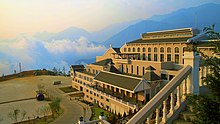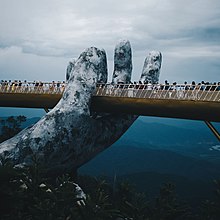
Hanoi is the capital and second-most populous city of Vietnam. As evident by the literal translation of its name – 'inside the river' – portions of Hanoi's border are delineated by the Red and Black Rivers. As a municipality, Hanoi consists of 12 urban districts, 17 rural districts, and one district-level town. It has an area of 3,359.84 km2 (1,297.24 sq mi) and a population of 8,435,700 in 2022. In 2022, Hanoi has the second-highest gross regional domestic product of all Vietnam provinces and municipalities at 51.4 billion USD, behind Ho Chi Minh City. Hanoi Capital is also ASEAN 8th largest economy after Surabaya.

Transportation in Vietnam is improving rapidly in terms of both quantity and quality. Road traffic is growing rapidly but the major roads are dangerous and slow to travel on due to outdated design and an inappropriate traffic mix. In recent years, the construction of expressways has accelerated. Air travel is also important for long distance travel. Metro systems are under construction in the two metropolises of Hanoi and Ho Chi Minh City.

Ho Chi Minh City, commonly known as Saigon, is the most populous city in Vietnam, with a population of around 9.3 million in 2023. The city's geography is defined by rivers and canals, of which the eponymously-named Saigon River is the largest. As a municipality, Ho Chi Minh City consists of 16 urban districts, five rural districts, and one municipal city (sub-city). As the largest financial centre in Vietnam, Ho Chi Minh City has the highest gross regional domestic product out of all Vietnam provinces and municipalities, contributing around a quarter of the country's total GDP. Ho Chi Minh City's metropolitan area is ASEAN's 6th largest economy, also the biggest outside an ASEAN country capital.

Da Nang or Danang is the fifth-largest city in Vietnam by municipal population. It lies on the coast of the East Sea of Vietnam at the mouth of the Hàn River, and is one of Vietnam's most important port cities. As one of the country's five direct-controlled municipalities, it falls under the administration of the central government.
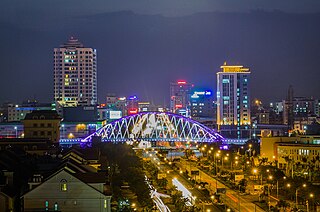
Haiphong is the third-largest city in Vietnam and is the principal port city of the Red River Delta. The municipality has an area of 1,526.52 km2 (589.39 sq mi), consisting of 8 urban districts and 7 rural districts. Two of the rural districts cover islands in the South China Sea: Bạch Long Vĩ and Cát Hải. It has a population of 2,359,000 in 2021. The city's economy has strength in manufacturing, as evident by large industrial parks and numerous smaller traditional handicraft villages.

Bà Rịa–Vũng Tàu is a province of Vietnam. It is located on the coast of the country's Southeast region. It also includes the Côn Đảo islands, located some distance off Vietnam's southeastern coast. From 1954 to 1975, under South Vietnam, the province was called Phước Tuy.

Phong Nha-Kẻ Bàng is a national park and UNESCO World Heritage Site in the Bố Trạch and Minh Hóa districts of central Quảng Bình Province in the North Central Coast region of Vietnam, about 500 km south of Hanoi. The park borders the Hin Namno National Park in Khammouane Province, Laos to the west and 42 km east of the East sea from its borderline point. Phong Nha-Kẻ Bàng National Park is in a limestone zone of 2,000 km2 in Vietnamese territory and borders another limestone zone of 2,000 km2 of Hin Namno in Laotian territory. The core zone of this national park covers 857.54 km2 and a buffer zone of 1,954 km2.

Vinh is the biggest city and economic and cultural center of North-Central Vietnam. Vinh is the capital of Nghệ An Province, and is a key point in the East–West economic corridor linking Myanmar, Thailand, Laos and Vietnam. The city is situated in the Southeast of the province, alongside the Lam River and is located on the main north–south transportation route of Vietnam, easily accessible by highway, railroad, boat and air. The recently expanded Vinh International Airport is served daily by four carriers: Vietnam Airlines, VietJet Air, Bamboo Airways and Jetstar Pacific. On September 5, 2008, it was upgraded from Grade-II city to Grade-I city, the fifth Grade-I city of Vietnam after Haiphong, Đà Nẵng and Huế. Vinh is the most populous city in the North Central Coastal region, with over 490,000 residents. The city is bordered by Nghi Loc district to the north and east, Hung Nguyen district to the west, and Nghi Xuan district in Hà Tĩnh Province to the south. Vinh is about 300 kilometres (190 mi) south of Hanoi and 1,400 kilometres (870 mi) north of Ho Chi Minh City. The total area of Vinh city is 104.97 square kilometres (40.53 sq mi), and includes 16 urban wards and 9 suburban communes.
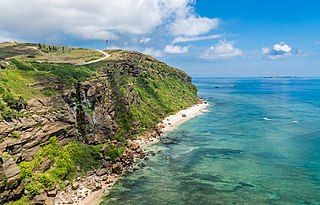
Quảng Ngãi is a northern coastal province in the South Central Coast region, the Central of Vietnam. It borders Quảng Nam to the north, Bình Định to the south, Kon Tum to the west, Gia Lai to the southwest and the East Sea to the east.

Quảng Ninh or Quangninh is a province along the northeastern coast of Vietnam. It is about 153 km (95 mi) east of Hanoi, comprising four cities, two district-level towns and seven rural districts. The provincial capital is Hạ Long. The province covers an area of 6,207.95 km2 (2,396.90 sq mi) and, as of 2023, had a population of 1,413,452. Nearly 80% of the province is mountainous with abundant land, forest, water and mineral resources, with 90% of Vietnam's coal output extracted from the province. The province is also home to Hạ Long Bay, a World Heritage Site that has 1,969 islands, out of which 989 have been given names.

In Vietnam, South Central Coast and South Central Region are two terms which can refer to the same region or two regions that do not correspond to each other. South Central Coast consists of the independent municipality of Đà Nẵng and seven other provinces, which means South Central Coast doesn't include Central Highlands. Nevertheless, the term "South Central Region" can also be used to include Central Highlands as it is part of southern part of Central Vietnam.

Vietnam Railways is the state-owned operator of the railway system in Vietnam. The principal route is the 1,727 km (1,100 mi) single-track North–South Railway line, running between Hanoi and Ho Chi Minh City. This was built at the metre gauge in the 1880s during the French colonial rule. There are also standard gauge lines running from Hanoi to the People’s Republic of China, eventually leading to Beijing, and some mixed gauge in and around Hanoi.

Đồng Hới is the capital city of Quảng Bình Province in the north central coast of Vietnam. The city's area is 155.71 km2 (60.12 sq mi). Population as per the 2019 census was 133,672. It is served by National Highway 1A, the Đồng Hới Railway Station, and airport. By road, Đồng Hới is 486 kilometres (302 mi) south of Hanoi, 195 kilometres (121 mi) south of Vinh, 160 kilometres (99 mi) north of Huế and 1,204 kilometres (748 mi) north of Hồ Chí Minh City. It borders Quảng Ninh District on the west and south, the South China Sea on the east, Bố Trạch District on the north.

Dong Hoi Airport is an airport located in Loc Ninh commune, 6 km north of Đồng Hới city, capital of Quảng Bình Province, in North Central Coast of Vietnam, about 500 km South-east of Hanoi by road. The facilities cover 173 ha, on a sandy area, by the coast of South China Sea. The runway approaches near the seashore and nearly parallel to the Highway 1. The airport, like all civil airports in Vietnam, is owned and operated by Airports Corporation of Vietnam.
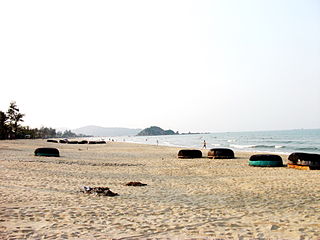
Nghệ An is a coastal province near the northernmost part of the North Central Coast region, Central Vietnam. It borders Thanh Hóa to the north, Hà Tĩnh to the south, Xiangkhouang, Bolikhamsai and Houaphan of Laos to the west, and the East Sea to the east.

Lệ Thủy is a district of Quảng Bình province in the North Central Coast of Vietnam. The district borders Quảng Ninh district on the north, Vĩnh Linh district on the south, Laos on the west. Lệ Thủy central is 40 km south of the provincial capital Đồng Hới. The district government seat is Kiến Giang Township. The district area is 1420.52 km2, population: 140,804 (1998). Lệ Thủy district is home to Võ Nguyên Giáp and the family of Ngô Đình Diệm. Economy bases on agriculture, mainly rice culture. Mỹ Trạch massacre by French army happened here on 29 November 1947.
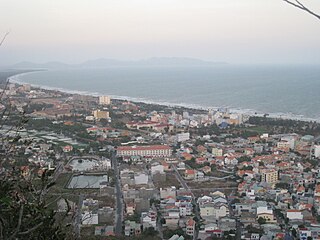
Đông Nam Bộ is a region in Vietnam. This region includes one municipality, Ho Chi Minh City; and five provinces: Đồng Nai, Bình Dương, Bà Rịa–Vũng Tàu province, Bình Phước and Tây Ninh. The two south central provinces Ninh Thuận and Bình Thuận are sometimes seen as part of the Southeast region. This region is the most economically developed region in Vietnam. In 2006, this region contributed 148,000 billion VND out of 251,000 billion VND to the state budget. This region is also the most highly urbanized in the country with more than 50% people living in urban areas.

Ho Chi Minh City metropolitan area is a metropolitan area that was in June 2008 proposed by the Ministry of Construction of Vietnam to the Government of Vietnam for approval. According to this master plan, this metropolitan area will include provinces around Ho Chi Minh City in the Southeast region and 2 provinces in the Mekong Delta region.
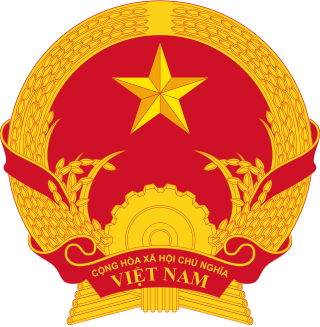
Visitors to Vietnam must obtain either an e-Visa or a visa in advance, unless they are citizens of one of the visa-exempt countries.

